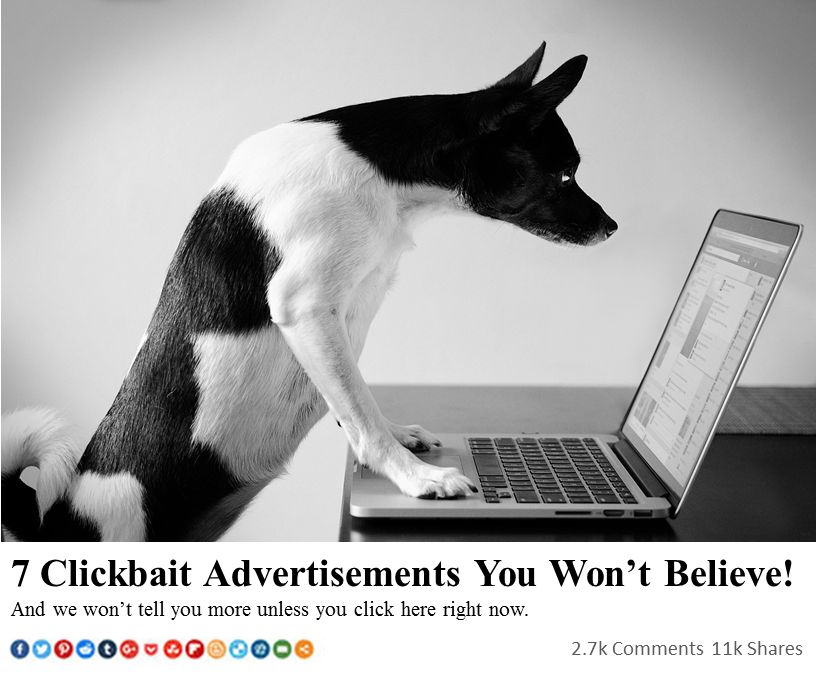Introduction
Clickbait is a catchy, attention-grabbing, often sensationalized headline, title, or image that hyperlinks to a web page. Clickbait headlines are designed to appeal to readers’ curiosity, tempting them to click on the link. This publication provides an overview of clickbait and its characteristics. The publication also discusses a few implications of clickbait use.
What is clickbait?
Clickbait is a marketing and engagement strategy designed to encourage readers to click on the headline. Clicks on the headline or image drive page views and increase the advertisement revenue of the site. However, the content of the clickbait headline is usually of questionable accuracy. Sometimes, clickbait headlines also incorporate images that are sensational in nature (Figures 1 and 2). Some examples of clickbait headlines include:
- “You’ll never believe…”
- “You should know these 5 things about…”
- “This easy trick will save you…”
- “This is what happens when you…”

Credit: GreenMeansGo via Wikimedia Commons (https://commons.wikimedia.org/wiki/Main_Page)

Credit: Lord Belbury via Wikimedia Commons (https://commons.wikimedia.org/wiki/Main_Page)
Clickbait has proven to be an effective marketing strategy to generate page views because it activates readers’ curiosity (Pengnate et al., 2021). Readers get the impression that the information they are searching for is within the article behind the clickbait headline. University of California Berkeley neuroeconomist Ming Hsu said, “The way our brains respond to the anticipation of a pleasurable reward is an important reason why people are susceptible to clickbait” (Counts, 2019).
Characteristics of Clickbait
Clickbait headlines are commonly used in social media and blogs. Clickbait can even be found on reputable websites, such as those of weather and news agencies, when they offer advertising space to clickbait content. It may be difficult to distinguish between clickbait and a legitimate headline. To help you identify clickbait, look for these characteristics:
Clickbait uses words that pique curiosity, such as:
- Catastrophic
- Spellbinding
- Inspiring
- Heartwarming
- Masterful
- Exclusive
- Reassuring
Clickbait can use humor to establish a positive emotional connection with readers.
Clickbait is often written in all caps.
Clickbait often incorporates data or numbers. Headlines that contain data, percentages, or numbers help quantify potential benefits for readers, such as, “8 Surefire Ways to Know Your Clothes Are Out of Style.”
Clickbait and Trust
If your goal is to be seen as a trustworthy and credible source of information, do not use clickbait-style writing methods. Instead, create an engaging and accurate headline that genuinely reflects your content's value and purpose.
Be aware of clickbait titles when you seek out information. If you see some of the previously described writing techniques in a title or photo, you may be clicking on clickbait, and you will likely not find the trustworthy and credible information you were hoping for.
Summary
Clickbait is a method to drive online readers to web pages, usually through exaggerated claims or misleading information. Credible sources of information should not use clickbait-style writing. By understanding the nature of clickbait and the characteristics of clickbait-style writing described in this article, readers can also identify and avoid clickbait.
References
Counts, L. (2019). How Information Is Like Snacks, Money, and Drugs – to Your Brain. BerkeleyHaas. Retrieved from https://newsroom.haas.berkeley.edu/how-information-is-like-snacks-money-and-drugs-to-your-brain/
Pengnate, S., Chen, J., & Young, A. (2021). Effects of Clickbait Headlines on User Responses: An Empirical Investigation. Journal of International Technology and Information Management, 30 (3). https://doi.org/10.58729/1941-6679.1440
Other Sources
Anderer, J. (2022). Study exposes how Facebook “clickbait” entices users into reading posts. Retrieved from https://studyfinds.org/facebook-clickbait-entices-users/
Brown, N. (2018). How Content Marketers Can Use the Power of Clickbait for Good. Retrieved from https://www.skyword.com/contentstandard/how-content-marketers-can-use-the-power-of-clickbait-for-good/
Collins, K., Shiffman, D., & Rock, J. (2016). How are scientists using social media in the workplace? PLOS ONE, 11 (10). Retrieved from https://doi.org/10.1371/journal.pone.0162680
Garcia, J. J., Colodro-Conde, L., Barlow, F., & Medland, S. (2022). Scientific Clickbait: Examining Media Coverage and Readability in Genome-Wide Association Research. Retrieved from https://doi.org/10.31234/osf.io/w29as
Georgiou, M. (2016). Write compelling headlines instead of clickbaits. Search Engine Journal. Retrieved from https://www.searchenginejournal.com/combating-clickbait-compelling-headlines/162897/
Indurthi, V., Syed, B., Gupta, M., & Varma, V. (2020). Predicting Clickbait Strength in Online Social Media. Proceedings of the 28th International Conference on Computational Linguistics, 4835–4846. Retrieved from https://doi.org/10.18653/v1/2020.coling-main.425
Iyengar, S., & Massey, D. S. (2018). Scientific Communication in a Post-Truth Society. Proceedings of the National Academy of Sciences, 7656–7661. Retrieved from https://doi.org/10.1073/pnas.1805868115
Pengnate, S. F. (2016). Measuring Emotional Arousal in Clickbait: Eye-Tracking Approach. Twenty-Second Americas Conference on Information Systems, 1–9. Retrieved from https://aisel.aisnet.org/amcis2016/HCI/Presentations/3/
Venneti, L., & Alam, A. (2018). How Curiosity Can Be Modeled for a Clickbait Detector. Retrieved from https://doi.org/10.48550/arXiv.1806.04212
Xu, Z., Laffidy, M., & Ellis, L. (2022). Clickbait for Climate Change: Comparing Emotions in Headlines and Full-Texts and Their Engagement. Information, Communication & Society, 1–18. Retrieved from https://doi.org/10.1080/1369118x.2022.2050416